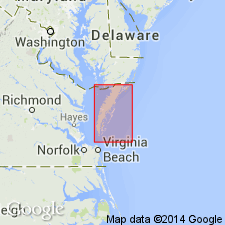
- Usage in publication:
-
- Joynes Neck Sand*
- Modifications:
-
- Named
- Dominant lithology:
-
- Sand
- AAPG geologic province:
-
- Atlantic Coast basin
Summary:
Yellowish-gray, loose, fine to coarse, surficial quartz sand, interstratified with beds of pebbly sand and gravel, are here named the Joynes Neck Sand. It occurs along the east side of the Delmarva Peninsula in Accomack and Northampton Cos., VA. Truncates and disconformably overlies the Accomack Member of the Omar Formation. Thickness at type section is 30 ft (9 m). Age is Pleistocene.
Source: GNU records (USGS DDS-6; Reston GNULEX).

- Usage in publication:
-
- Joynes Neck Sand
- Modifications:
-
- Overview
- AAPG geologic province:
-
- Atlantic Coast basin
Summary:
Nomenclature on State map follows Mixon (1985). Joynes Neck Sand is described here as yellowish-gray, fine to coarse sand coarsening downward to gravelly sand and sandy gravel. Cross-lamination in finer-grained sands is accentuated by black, heavy minerals. Unit was deposited in nearshore-shelf depositional environment. Is surficial deposit of coast-parallel terrace (altitude 23-26 ft) on eastern side of upland in Accomack Co., east of Chesapeake Bay. Thickness ranges from 0 to 30 ft. Age is late Pleistocene.
Source: GNU records (USGS DDS-6; Reston GNULEX).
For more information, please contact Nancy Stamm, Geologic Names Committee Secretary.
Asterisk (*) indicates published by U.S. Geological Survey authors.
"No current usage" (†) implies that a name has been abandoned or has fallen into disuse. Former usage and, if known, replacement name given in parentheses ( ).
Slash (/) indicates name conflicts with nomenclatural guidelines (CSN, 1933; ACSN, 1961, 1970; NACSN, 1983, 2005, 2021). May be explained within brackets ([ ]).

